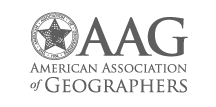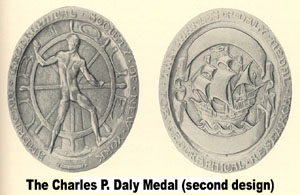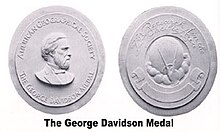
The Royal Geographical Society (with the Institute of British Geographers), often shortened to RGS, is a learned society and professional body for geography based in the United Kingdom. Founded in 1830 for the advancement of geographical sciences, the society has 16,000 members, with its work reaching the public through publications, research groups and lectures.

The American Geographical Society (AGS) is an organization of professional geographers, founded in 1851 in New York City. Most fellows of the society are Americans, but among them have always been a significant number of fellows from around the world. The society encourages activities that expands geographical knowledge, and the interpretation of that knowledge so that it can be useful to geographers and other disciplines, especially in a policymaking environment. It is the oldest nationwide geographical organization in the United States. Over the century and a half of its existence, the AGS has been especially interested in three regions: the Arctic, the Antarctic, and Latin America. A signature characteristic of the AGS-sponsored exploration was the requirement that its expeditions produce tangible scientific results.

Jack Dangermond is an American billionaire businessman and environmental scientist, who in 1969 co-founded, with Laura Dangermond, the Environmental Systems Research Institute (Esri), a privately held geographic information systems (GIS) software company. As of July 2023, his net worth was estimated at US$9.3 billion.

Isaiah Bowman, AB, Ph. D., was an American geographer and President of the Johns Hopkins University, 1935–1948, controversial for his antisemitism and inaction in Jewish resettlement during WWII.

Sir Raymond William Firth was an ethnologist from New Zealand. As a result of Firth's ethnographic work, actual behaviour of societies is separated from the idealized rules of behaviour within the particular society. He was a long serving professor of anthropology at the London School of Economics, and is considered to have singlehandedly created a form of British economic anthropology.

John Kirtland Wright (1891–1969) was an American geographer, notable for his cartography, geosophy, and study of the history of geographical thought. He was the son of classical scholar John Henry Wright and novelist Mary Tappan Wright, and the brother of legal scholar and utopian novelist Austin Tappan Wright. He married Katharine McGiffert Jan. 21, 1921 in New York, N.Y. They had three children: Austin McGiffert Wright, Gertrude Huntington McPherson, and Mary Wolcott Toynbee.

The American Association of Geographers (AAG) is a non-profit scientific and educational society aimed at advancing the understanding, study, and importance of geography and related fields. Its headquarters is located in Washington, D.C. The organization was founded on December 29, 1904, in Philadelphia, as the Association of American Geographers, with the American Society of Professional Geographers later amalgamating into it in December 1948 in Madison, Wisconsin. As of 2020, the association has more than 10,000 members, from nearly 100 countries. AAG members are geographers and related professionals who work in the public, private, and academic sectors.
The Victoria Medal is an award presented by the Royal Geographical Society. It is awarded "for conspicuous merit in research in geography" and has been given since 1902, in honour of the late Queen Victoria. Up until then, the society's Patron's Medal had alternatively been known as the "Victoria Medal", and the new medal resembled its original design.
Professor George Kish (1914–1989) was an internationally recognized authority known for work in geography and the history of cartography. His professional papers are held at the Bentley Historical Library in Ann Arbor.

George Davidson was a geodesist, astronomer, geographer, surveyor and engineer in the United States.

Sir (Laurence) Dudley Stamp, CBE, DSc, D. Litt, LLD, Ekon D, DSc Nat, was professor of geography at Rangoon and London, and one of the internationally best known British geographers of the 20th century.

George Babcock Cressey was an American geographer, author, and academic. Born in Tiffin, Ohio, he attended Denison University and then the University of Chicago, where he received a PhD in geology. After receiving his degree, he taught at University of Shanghai and traveled widely in China. Upon his return to the United States in 1929, he completed a pioneering book on the country, China's Geographic Foundations.

The Charles P. Daly Medal is awarded to individuals by the American Geographical Society (AGS) "for valuable or distinguished geographical services or labors." The medal was established in 1902. This medal was originally designed by Victor D. Brenner, but the destruction of the dies caused the medal to be redesigned in 1924 by Brenda Putnam.

Herbert Ernest Gregory was a Yale University geologist well known for his early 20th-century explorations of the Colorado Plateau in Arizona and Utah. One of his most important works is Colorado Plateau Region, published by the United States Geological Survey on the occasion of the United States sponsoring the 16th International Geological Congress.
David Ross Stoddart, was a British physical geographer known for the study of coral reefs and atolls. He was also known for key works on the history and philosophy of geography as an academic discipline. He was a lecturer at the University of Cambridge, and then professor and later emeritus professor at the University of California, Berkeley.
Robert Burnett Hall, born in Española, New Mexico, was an American geographer known for his work on Japan. He taught for most of his career at University of Michigan, Ann Arbor.
David Lowenthal was an American historian and geographer, renowned for his work on heritage. He is credited with having made heritage studies a discipline in its own right.
Reece Jones is an American political geographer and Guggenheim Fellow. Jones was educated at the University of North Carolina at Chapel Hill and the University of Wisconsin–Madison.

Joseph Russell Smith was an American geographer. He worked in the Department of Geography and Industry at the University of Pennsylvania and later the Columbia Business School where he chaired the economic geography program. From 1941 to 1942, he was president of the American Association of Geographers.
John Fraser Hart is an American geographer. Over the course of his career he published over 150 scholarly papers, over a dozen books, and taught over 50,000 university students in his 65 years of teaching from 1949 until his retirement in 2015.













